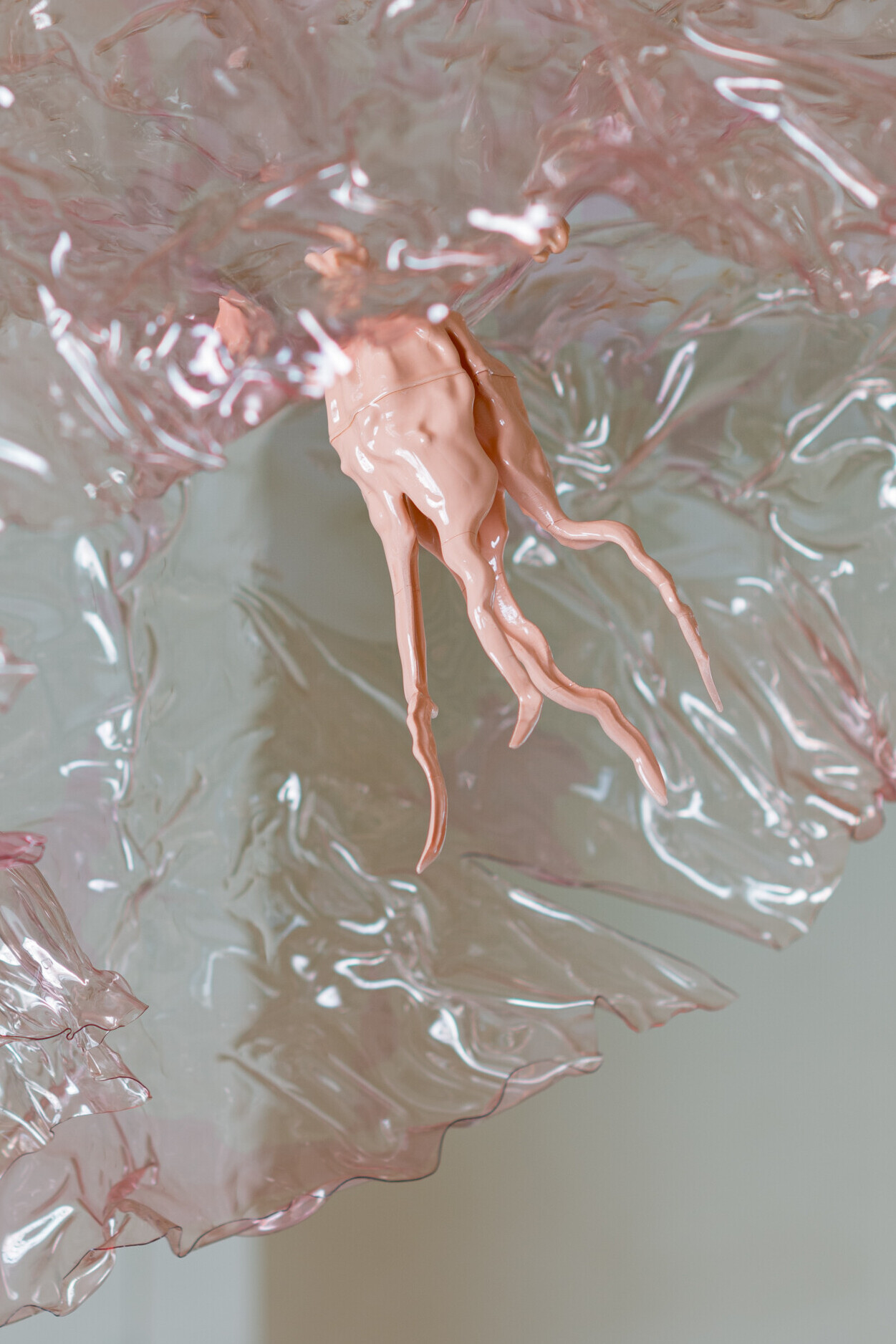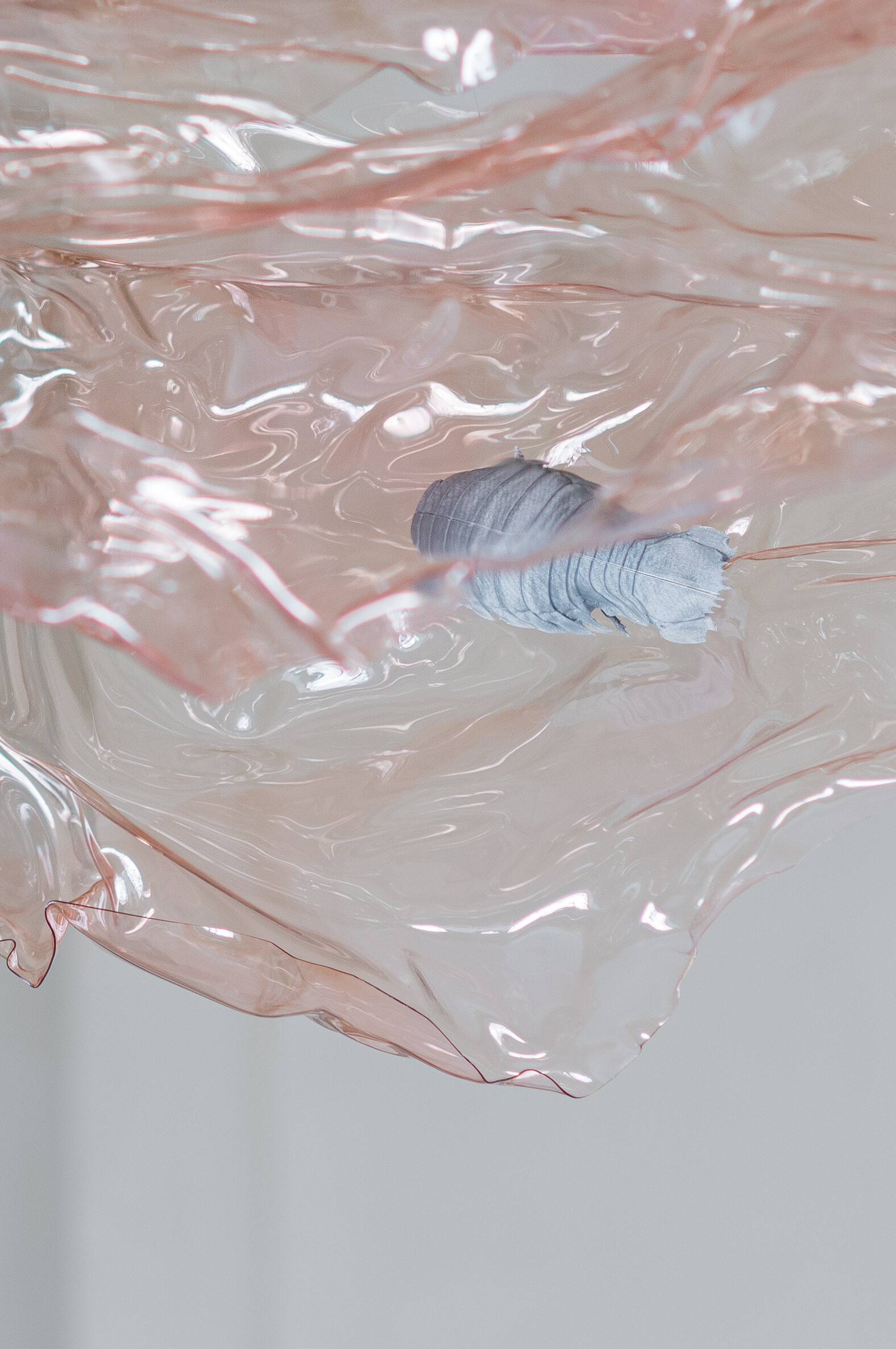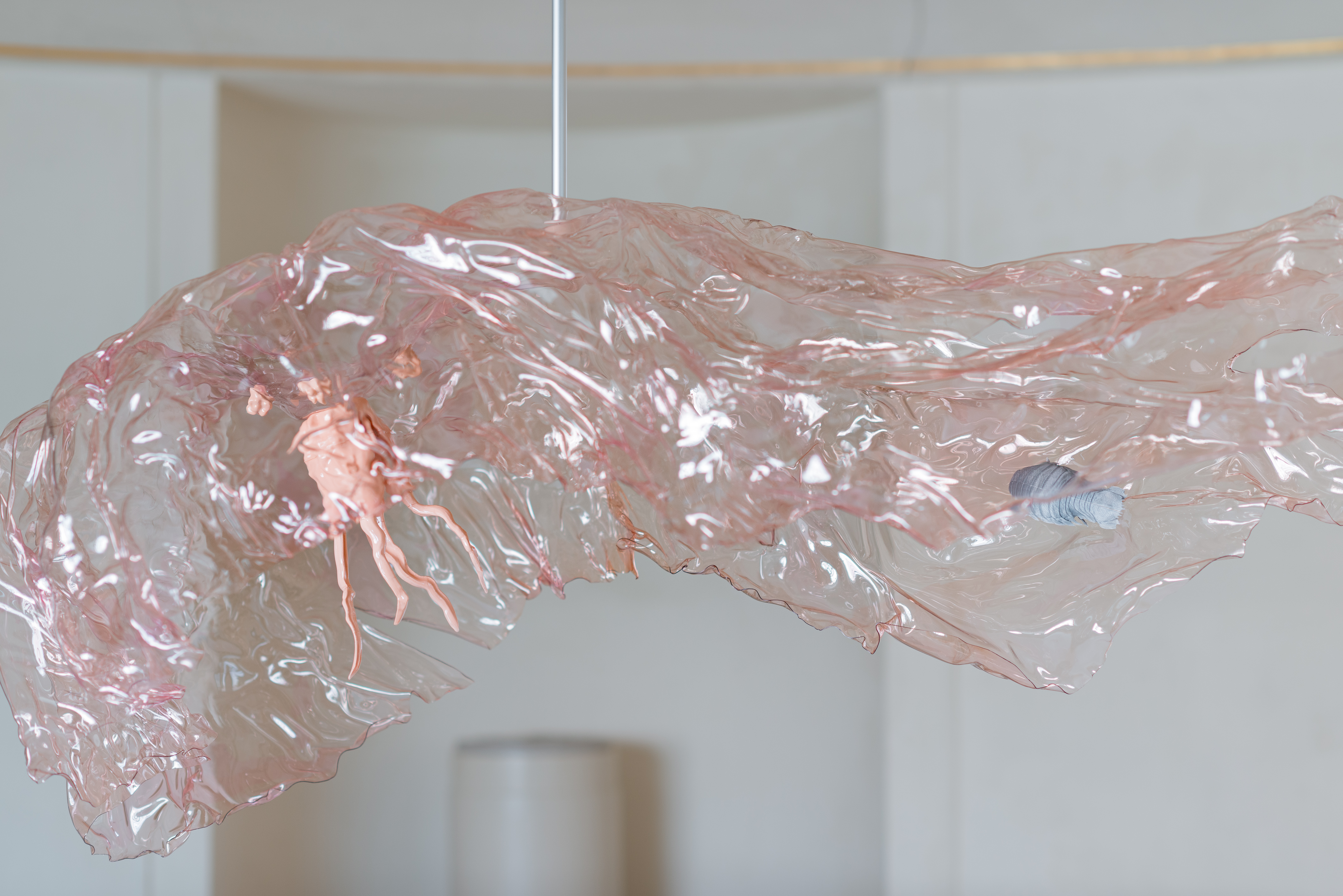DIE INSTALLATION „DEEPSTAR“ IST (…) KEINE FIKTION, SONDERN GEHT AUF EINE WISSENSCHAFTLICHE ENTDECKUNG ZURÜCK. DARAUF VERWEIST AUCH IHR TITEL. „DEEPSTAR 4000“ WAR DER NAME EINES VON DEM BERÜHMTEN OZEANOGRAFEN UND MEERESFORSCHER JACQUES COUSTEAU ENTWORFENES UND 1965 VON WESTINGHOUSE GEBAUTES TAUCHBOOT. MIT IHM WURDE EIN JAHR SPÄTER VOR DER SÜDKALIFORNISCHEN KÜSTE IN EINER TAUCHTIEFE VON 723 METERN EINE BIS DAHIN UNBEKANNTE QUALLE ENTDECKT. NACH DEM BOOT, DESSEN TECHNIK DIE ENTDECKUNG DES IN DER TIEFSEE LEBENDEN TIERES ÜBERHAUPT ERST MÖGLICH GEMACHT HATTE, WURDE SIE „DEEPSTARIA“ GENANNT. UND WEIL SIE VON SO GEHEIMNISVOLLEM AUSSEHEN WAR – EIN IM JAHR 2012 VON EINEM TAUCHROBOTER IN EINER TIEFE VON 1590 METERN GESICHTETES EXEMPLAR WURDE ZUNÄCHST FÜR DIE PLAZENTA EINES WALS GEHALTEN –, ERHIELT DIE QUALLE DAS ZUSÄTZLICHE ADJEKTIV „ENIGMATICA“, LATEINISCH FÜR RÄTSELHAFT. WAS WIR SEHEN, WENN WIR AUF CHRISTIAN HOLLS „DEEPSTAR“ SCHAUEN, IST EIN FLUIDES UND FRAGILES, ROSAFARBEN SCHIMMERNDES GEBILDE VON ZARTER TRANSPARENZ UND ZAUBERHAFTER PRÄSENZ. ES HÄNGT AN EINER AN DER DECKE DES AUSSTELLUNGSRAUMES BEFESTIGTEN METALLSTANGE, SODASS DIE QUALLE IN DER LUFT SCHWEBT, ALS TREIBE SIE DURCH WASSER. SIE ENTSPRICHT IN IHREN MASSEN MIT EINEM DURCHMESSER VON ETWA 60 CM ZIEMLICH GENAU IHREM NATÜRLICHEN VORBILD, DAS INDES NICHT GUT ERFORSCHT IST, WEIL ES SO SELTEN VORKOMMT. IN DER LITERATUR WIRD DIE QUALLE ALS FARBLOS BESCHRIEBEN, AUCH EIN BRÄUNLICHES EXEMPLAR SOLL SCHON GESICHTET WORDEN SEIN, WAS HOLL MIT SEINEM ROKOKOHAFTEN KOLORIT KLAR ZUM KUNSTSCHÖNEN HIN VERÄNDERT HAT. ALS FESTKÖRPER SEHEN WIR AUF DER LINKEN SEITE MUND UND AFTER ZUSAMMEN MIT DEN VIER TENTAKELN, DURCH DIE SICH DIE QUALLE NAHRUNG ZUFÜHRT, DARÜBER IHRE KEIMDRÜSEN, DIE GONADEN, AUCH SIE IN WEICHEM ROSÉ. AUF DER RECHTEN SEITE DAGEGEN IN METALLISCHEM GRAU EINE TIEFSEEASSEL. SIE IST DER NATÜRLICHE FEIND VON DEEPSTARIA UND UNTERHÄLT EIN PARASITÄRES VERHALTEN ZU IHR. SIE LEBT ZUMINDEST ZEITWEISE IM SCHIRM DES TIERES UND SCHEINT SICH VON SEINEN ORGANEN ZU ERNÄHREN. DIE DRAMATISCHE KONFRONTATION BEIDER HAT HOLL DURCH IHRE FARBIGKEIT UND TEXTUR PRONONCIERT. DIE ORGANE DER QUALLE HAT ER DABEI FREI NACH BILDVORLAGEN AM COMPUTER MODELLIERT UND SIE DANN MIT DEM 3D-DRUCKER GESCHAFFEN. DIE ASSEL BASIERT DAGEGEN AUF DEM LEICHT MODIFIZIERTEN 3D-SCAN EINER ECHTEN TIEFSEEASSEL. DOCH WIE MINIMAL HOLLS EINGRIFFE AUCH SEIN MÖGEN, IHRE WIRKUNG IST PHÄNOMENAL. DIE ASSEL SIEHT IM VULNERABLEN GESPINST DER QUALLE AUS WIE EIN TECHNOIDER FREMDKÖRPER, DER NICHT VON UNGEFÄHR AN DIE FORM EINER HANDGRANATE ERINNERT. DER KAMPF, DEN DIE NATUR HIER IN DER INSZENIERUNG HOLLS IN GESTALT VON ZWEIEN IHRER PROTAGONISTINNEN GEGEN SICH SELBST FÜHRT, LÄSST AN DAS DESTRUKTIVE VERHÄLTNIS DENKEN, DAS HEUTE OFT ZWISCHEN NATUR UND TECHNIK WIE ZWISCHEN MENSCH UND NATUR HERRSCHT, UND WIRD SO ZUM ANALOGON FÜR TAGTÄGLICHE KONFLIKTE. SIE HANDELN DAVON, WIE RÜCKSICHTSLOS UND LEBENSFEINDLICH DER AUF PROFITMAXIMIERUNG BEDACHTE MENSCH MIT DER NATUR UMGEHT. UND WIE SEINE ERFINDUNGSKRAFT, WO SIE SICH GEGEN SIE WENDET, ZUR URSACHE SEINES EIGENEN UNTERGANG WERDEN KÖNNTE. JULIAN CHARRIÈRE, KÜNSTLERKOLLEGE VON HOLL, HAT IN DIESEM ZUSAMMENHANG DARAUF HINGEWIESEN, DASS DIE SCHLIMMSTE EROSIONSKRAFT DER NATUR HEUTE NICHT MEHR DIE NATUR, SONDERN DER MENSCH SEI. ABER VIELLEICHT KOMMT HOFFNUNG AUS DEM HABITAT VON CHRISTIAN HOLLS PROTAGONISTINNEN. DIE MEERESBODEN-RELIEFS, DIE ER IN SYMBOLHAFTER WEISE GLEICHFALLS FÜR SEINE INSTALLATION GESCHAFFEN HAT, STAMMEN VOM WESTLICHEN PAZIFISCHEN OZEAN. DORT BEFINDET SICH DER 11.000 METER UNTER DEM MEERESSPIEGEL LIEGENDE MARIANENGRABEN. ER GEHÖRT ZU DEN 300 MILLIONEN QUADRATKILOMETERN MEERESBODEN DER ERDE, VON DENEN GERADE EINMAL FÜNF PROZENT ERFORSCHT SIND. LANGE GALT DIE DUNKLE UND KALTE WASSERTIEFE ALS EBENSO LEBENSFEINDLICH WIE DAS WELTALL. ABER VIELLEICHT WERDEN DAS MEER WIE DER MOND BALD ZU DEM, WAS SIE IN DEN DER ZUKUNFT ZUGEWANDTEN SCIENCE FICTION-ROMANEN SCHON LANGE SIND: NEUE HEIMAT FÜR ERDMÜDE MENSCHEN.







